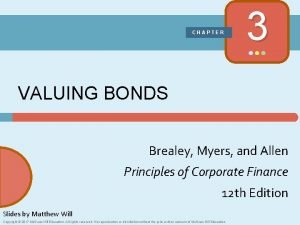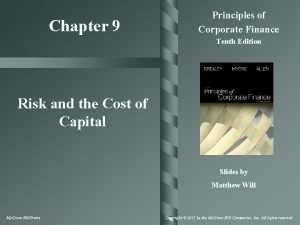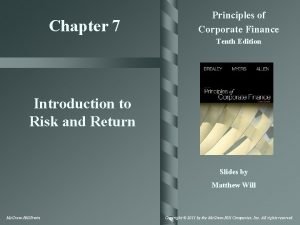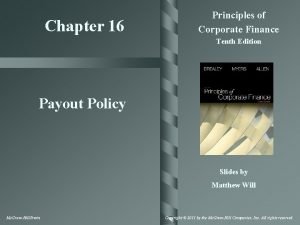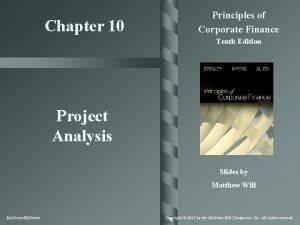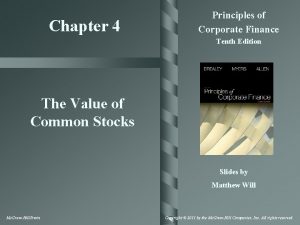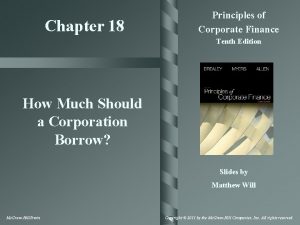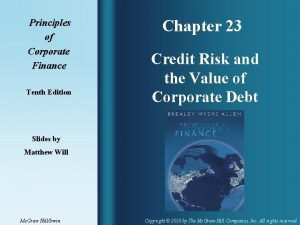Chapter 15 Principles of Corporate Finance Tenth Edition




















- Slides: 20

Chapter 15 Principles of Corporate Finance Tenth Edition How Corporations Issue Securities Mc. Graw-Hill/Irwin Copyright © 2011 by the Mc. Graw-Hill Companies, Inc. All rights reserved.

Topics Covered Ø Venture Capital Ø The Initial Public Offering Ø Alternative Issue Procedures for IPOs Ø Security Sales by Public Companies – Rights Issue Ø Private Placements and Public Issues 15 -2

Venture Capital Money invested to finance a new firm Since success of a new firm is highly dependent on the effort of the managers, restrictions are placed on management by the venture capital company and funds are usually dispersed in stages, after a certain level of success is achieved. 15 -3

Venture Capital 15 -4

Venture Capital 15 -5

U. S. Venture Capital Investments 15 -6

Initial Offering Initial Public Offering (IPO) - First offering of stock to the general public. Underwriter - Firm that buys an issue of securities from a company and resells it to the public. Spread - Difference between public offer price and price paid by underwriter. Prospectus - Formal summary that provides information on an issue of securities. Underpricing - Issuing securities at an offering price set below the true value of the security. 15 -7

15 -8 Motives For An IPO Percent of CFOs who strongly agree with the reason for an IPO To create public shares for use in future acquisitions 59, 4 To establish a market price/value for our firm 51, 2 To enhance the reputation of our company 49, 1 To broaden the base of ownership 45, 9 To allow one or more principals to diversify personal holdings 44, 1 To minimize our cost of capital 42, 5 To allow venture capitalists to cash out 32, 2 To attract analysts' attention 29, 8 Our company has run out of private equity 27, 6 Debt is becoming too expensive 14, 3 0 10 20 30 40 50 60 70

The Top Managing Underwriters January – December 2008 15 -9

Average Initial IPO Returns 15 -10

Initial Offering Average Expenses on 1767 IPOs from 1990 -1994 15 -11

15 -12 IPO Proceeds Ø IPO Proceeds and First Day Returns 80 70 60 50 40 Issue proceeds ($bn) First-day return 30 20 10 2008 2007 2006 2005 2004 2003 2002 2001 2000 1999 1998 1997 1996 1995 1994 1993 1992 1991 1990 0

General Cash Offers Seasoned Offering - Sale of securities by a firm that is already publicly traded. General Cash Offer - Sale of securities open to all investors by an already public company. Shelf Registration - A procedure that allows firms to file one registration statement for several issues of the same security. Private Placement - Sale of securities to a limited number of investors without a public offering. 15 -13

Underwriting Spreads (2008) 15 -14

Total Direct Costs of Raising Capital 15 -15

Rights Issue - Issue of securities offered only to current stockholders. Example – Xstrata needs to raise £ 4. 1 billion of new equity. The market price is £ 6. 23/sh. Xstrata decides to raise additional funds via a 2 for 1 rights offer at £ 2. 10 per share. If we assume 100% subscription, what is the value of each right? 15 -16

Rights Issue Example - Xstrata needs to raise £ 4. 1 billion of new equity. The market price is £ 6. 23/sh. Xstrata decides to raise additional funds via a 2 for 1 rights offer at £ 2. 10 per share. If we assume 100% subscription, what is the value of each right? ÞCurrent Market Value = 1 x £ 6. 23 = £ 6. 23 ÞTotal Shares = 2+ 1 = 3 ÞAmount of new funds = 2 x £ 2. 10 = £ 4. 20 ÞNew Share Price = (6. 23+4. 20) / 3 = £ 3. 48 ÞValue of a Right = 3. 48 – 2. 10 = £ 1. 38 15 -17

Rights Issue Slightly More Difficult Example Lafarge Corp needs to raise € 1. 28 billion of new equity. The market price is € 60/sh. Lafarge decides to raise additional funds via a 4 for 17 rights offer at € 41 per share. If we assume 100% subscription, what is the value of each right? 15 -18

Rights Issue Example - Lafarge Corp needs to raise € 1. 28 billion of new equity. The market price is € 60/sh. Lafarge decides to raise additional funds via a 4 for 17 rights offer at € 41 per share. If we assume 100% subscription, what is the value of each right? ÞCurrent Market Value = 17 x € 60 = € 1, 020 ÞTotal Shares = 17 + 4 = 21 ÞAmount of funds = 1, 020 + (4 x 41) = € 1, 184 ÞNew Share Price = (1, 184) / 21 = € 56. 38 ÞValue of a Right = 56. 38 – 41 = € 15. 38 15 -19

Web Resources Click to access web sites Internet connection required www. nvca. org www. evca. com www. asianfn. com www. pwcmoneytree. com www. v 1. com www. vnpartners. com/primer. htm 15 -20
 Corporate finance tenth edition
Corporate finance tenth edition Corporate finance tenth edition
Corporate finance tenth edition Corporate finance tenth edition
Corporate finance tenth edition Corporate finance tenth edition
Corporate finance tenth edition Corporate finance tenth edition
Corporate finance tenth edition Principles of corporate finance chapter 3 solutions
Principles of corporate finance chapter 3 solutions Goal of corporate finance
Goal of corporate finance Fundamentals of corporate finance 3rd canadian edition
Fundamentals of corporate finance 3rd canadian edition Fundamentals of corporate finance canadian edition
Fundamentals of corporate finance canadian edition Fundamentals of corporate finance fifth edition
Fundamentals of corporate finance fifth edition Fundamentals of corporate finance 6th edition
Fundamentals of corporate finance 6th edition Campbell biology tenth edition
Campbell biology tenth edition Campbell biology tenth edition
Campbell biology tenth edition Campbell biology tenth edition
Campbell biology tenth edition Elementary statistics tenth edition
Elementary statistics tenth edition Floyd digital fundamentals 10th edition
Floyd digital fundamentals 10th edition Psychology tenth edition in modules
Psychology tenth edition in modules Introduction to genetic analysis tenth edition
Introduction to genetic analysis tenth edition Biology tenth edition
Biology tenth edition The graph shows data from the light colored soil enclosure
The graph shows data from the light colored soil enclosure Clorosplastos
Clorosplastos





